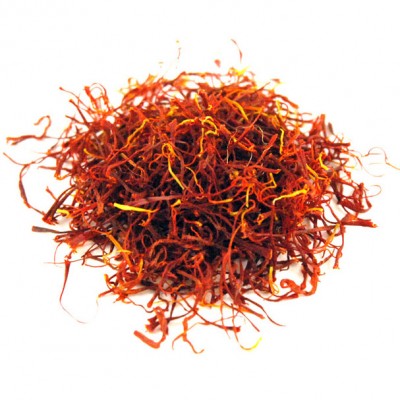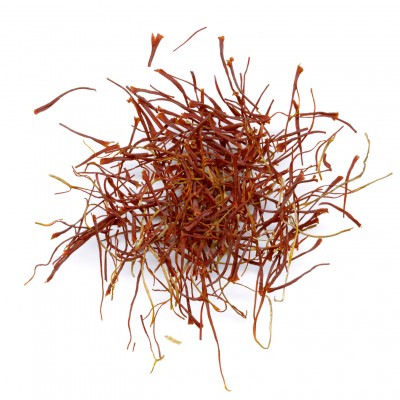Grades and ISO 3632 categories

Red threads and yellow styles from Iran.

High quality red threads from Austrian saffron.
Saffron is not all of the same quality and strength. Strength is related to several factors including the amount of style picked along with the red stigma. Age of the saffron is also a factor. More style included means the saffron is less strong gram for gram, because the colour and flavour are concentrated in the red stigmas. Saffron from Iran, Spain and Kashmir is classified into various grades according to the relative amounts of red stigma and yellow styles it contains. Grades of Iranian saffron are: “Sargol” (red stigma tips only, strongest grade), “Pushal” or “Pushali” (red stigmas plus some yellow style, lower strength), “bunch” saffron (red stigmas plus large amount of yellow style, presented in a tiny bundle like a miniature wheat sheaf) and “Konge” (yellow style only, claimed to have aroma but with very little, if any, colouring potential). Grades of Spanish saffron are “coupé” (the strongest grade, like Iranian Sargol), “Mancha” (like Iranian Pushal), and in order of further decreasing strength “Rio”, “standard” and “sierra” saffron. The word “Mancha” in the Spanish classification can have two meanings: a general grade of saffron or a very high quality Spanish-grown saffron from a specific geographical origin. Real Spanish-grown La Mancha saffron has protected status and this is displayed on the product packaging. Spanish growers fought hard for Protected Status because they felt that imports of Iranian saffron re-packaged in Spain and sold as “Spanish Mancha saffron” were undermining the genuine La Mancha brand.
In addition to descriptions based on how the saffron is picked, saffron may be categorized under the international standard ISO 3632 after laboratory measurement of crocin (responsible for saffron’scolour), picrocrocin (taste), and safranal (fragrance or aroma) content.However, often there is no clear grading information on the product packaging and little of the saffron readily available in UK is labeled with ISO category. This lack of information makes it hard for customers to make informed choices when comparing prices and buying saffron.
Under ISO 3632, determination of non-stigma content and other extraneous matter such as inorganic material are also key. ISO 3632 deals exclusively with saffron and establishes three categories: III (poorest quality), II, and I (finest quality). Formerly there was also category IV, which was below category III. Samples are assigned categories by gauging the spice’s crocin and picrocrocin content, revealed by measurements of specific spectrophotometric absorbance. Safranal is treated slightly differently and rather than there being threshold levels for each category, samples must give a reading of 20-50 for all categories.
These data are measured through reports at certified testing laboratories worldwide. Higher absorbances imply greater levels of crocin, picrocrocin and safranal, and thus a greater colouring potential and therefore strength per gram. The absorbance reading of crocin is known as the “colouring strength” of that saffron. Saffron’scolouring strength can range from lower than 80 (for all category IV saffron) up to 200 or greater (for category I). The world’s finest samples (the selected, most red-maroon, tips of stigmas picked from the finest flowers) receive colouring strengths in excess of 250, making such saffron over three times more powerful than category IV saffron. Sargol and coupé saffron would typically fall into ISO 3632 category I. Pushal and mancha would probably be assigned to category II. On many saffron packaging labels, neither the ISO 3632 category nor the colouring strength (the measurement of crocin content) is displayed.
However, many growers, traders, and consumers reject such lab test numbers. Some people prefer a more holistic method of sampling batches of threads for taste, aroma, pliability, and other traits in a fashion similar to that practised by experienced wine tasters. However, ISO 3632 grade and colouring strength information allow consumers to make instant comparisons between the quality of different saffron brands, without needing to purchase and sample the saffron. In particular, consumers can work out value for money based on price per unit of colouring strength rather than price per gram, given the wide possible range of colouring strengths that different kinds of saffron can have.
Despite attempts at quality control and standardisation, an extensive history of saffron adulteration, particularly among the cheapest grades, continues into modern times. Adulteration was first documented in Europe’s Middle Ages, when those found selling adulterated saffron were executed under the Safranschoucode.Typical methods include mixing in extraneous substances like beets, pomegranate fibres, red-dyed silk fibres, or the saffron crocus’s tasteless and odourless yellow stamens. Other methods included dousing saffron fibres with viscid substances like honey or vegetable oil to increase their weight. However, powdered saffron is more prone to adulteration, with turmeric, paprika, and other powders used as diluting fillers. Adulteration can also consist of selling mislabelled mixes of different saffron grades. Thus, in India, high-grade Kashmiri saffron is often sold and mixed with cheaper Iranian imports; these mixes are then marketed as pure Kashmiri saffron, a development that has cost Kashmiri growers much of their income.
